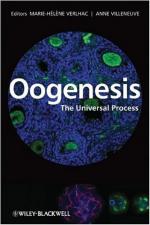|
This section contains 274 words (approx. 1 page at 300 words per page) |
Oogenesis is the process by which eggs develop in the ovaries. This process begins during development of the embryo. Three months into embryonic development, primitive egg cells called oogonia fill the ovaries of the developing female. Initially, these cells replicate through the process known as mitosis. Mitosis allows two identical daughter cells to be produced from a single original cell. All of these oogonia have the normal number of chromosomes (46).
After three months, however, the oogonia within the embryo begin to enter a new phase of development. Because the ultimate use of an egg is to unite with a sperm to create a new zygote, and because any such fertilizing sperm will carry 23 chromosomes of its own, the ultimate goal of the oogonia is to differentiate into an egg which itself carries 23 chromosomes. The union of the sperm and egg, then, will create an organism with the normal complement of 46 chromosomes.
To accomplish this "downsizing" of the chromosomes, oogonia utilize a process called meiosis. The first steps in the process of meiosis are begun during embryonic and fetal development, but the process is halted prior to birth. At its greatest, the number of egg cells reaches around 7 million; however, even before birth, the vast majority of these egg cells will regress and disappear. When a baby girl is born, her ovaries will contain about 400,000 primary oocytes. The final steps of meiosis will not be completed until the girl enters puberty. After puberty, a single primary ooctye will enter further stages of meiosis, although the final stages of meiosis are only completed by any primary oocyte which actually undergoes fertilization by a sperm.
|
This section contains 274 words (approx. 1 page at 300 words per page) |


